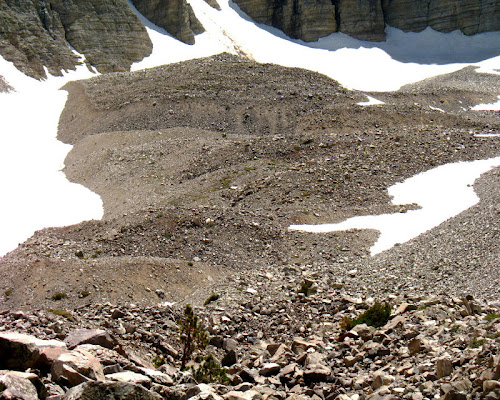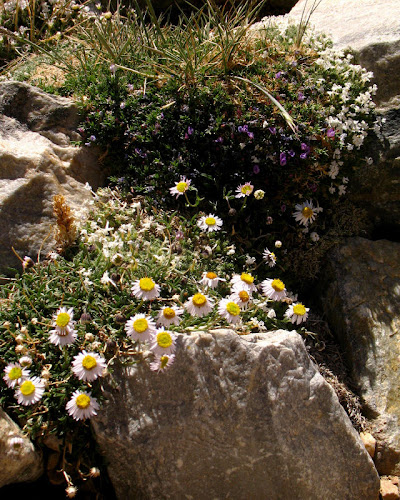 As you walk up onto the rock glacier (RG) on the north side of Wheeler Peak, you are walking through a rubbly, talus-ridden U-shaped valley. The talus is composed mostly of Prospect Mountain Quartzite, which has some interbeds of black shale or slate.
As you walk up onto the rock glacier (RG) on the north side of Wheeler Peak, you are walking through a rubbly, talus-ridden U-shaped valley. The talus is composed mostly of Prospect Mountain Quartzite, which has some interbeds of black shale or slate. The upper outcrops of the valley walls form spires and towers and hoodoo-like shapes. Talus looks like it will come sliding down at any moment, although no rock falls occurred the entire time we were in the cirque.
The upper outcrops of the valley walls form spires and towers and hoodoo-like shapes. Talus looks like it will come sliding down at any moment, although no rock falls occurred the entire time we were in the cirque. In order to make your way up the cirque valley, you either have to go off-trail and skirt the entire rock glacier (RG) on talus (not recommended or encouraged - or allowed? - by the Park Service), or you walk across several patches of firm to slightly slushy snow. Ski poles are something I would recommend. MOH and I had hiking poles, but we had taken the little ski-pole baskets off, and so our poles would sink into the snow. The poles would also get stuck occasionally in the rocks of the RG, and ski-pole-type baskets would have helped there, keeping the poles from going into gaps between the rocks.
In order to make your way up the cirque valley, you either have to go off-trail and skirt the entire rock glacier (RG) on talus (not recommended or encouraged - or allowed? - by the Park Service), or you walk across several patches of firm to slightly slushy snow. Ski poles are something I would recommend. MOH and I had hiking poles, but we had taken the little ski-pole baskets off, and so our poles would sink into the snow. The poles would also get stuck occasionally in the rocks of the RG, and ski-pole-type baskets would have helped there, keeping the poles from going into gaps between the rocks. An even closer view of the rock glacier (RG) shows its lumpy, irregular-looking lower portion, described as having a "hummocky surface, rounded front, and convex-up transverse cross-section" by Osborne and Bevis (2001). The upper portion of the RG, toward the cirque headwall, is set off from the lower portion by an abrupt edge, a slope of rock debris at the angle of repose. Behind the upper portion, you can see the snow (and buried ice or glacier? - is it still active?) that sits between the RG and the cirque headwall.
An even closer view of the rock glacier (RG) shows its lumpy, irregular-looking lower portion, described as having a "hummocky surface, rounded front, and convex-up transverse cross-section" by Osborne and Bevis (2001). The upper portion of the RG, toward the cirque headwall, is set off from the lower portion by an abrupt edge, a slope of rock debris at the angle of repose. Behind the upper portion, you can see the snow (and buried ice or glacier? - is it still active?) that sits between the RG and the cirque headwall.

 The rock glacier is not a lifeless place: lichen, patches of grass, and wildflowers grow here and there. In fact, when arriving at a certain point in the hike, somewhere on the lower part of the rock glacier, the distinct odor of skunk can be detected. At first we wondered - surely there are no skunks up this high! Was the Park Service remiss in listing skunks on their wildlife posters in camp? No, it's not skunk. It's those lovely purple flowers, above, which must have a name like skunkweed, or something like that. I crushed a small bit of their leaves, and sure enough: skunk! (Didn't try crushing the flowers; don't recommend this plant as one to eat under dire circumstances.)
The rock glacier is not a lifeless place: lichen, patches of grass, and wildflowers grow here and there. In fact, when arriving at a certain point in the hike, somewhere on the lower part of the rock glacier, the distinct odor of skunk can be detected. At first we wondered - surely there are no skunks up this high! Was the Park Service remiss in listing skunks on their wildlife posters in camp? No, it's not skunk. It's those lovely purple flowers, above, which must have a name like skunkweed, or something like that. I crushed a small bit of their leaves, and sure enough: skunk! (Didn't try crushing the flowers; don't recommend this plant as one to eat under dire circumstances.)References:
Osborn, G., 1990. The Wheeler Peak cirque and glacier/rock glacier. Unpublished report prepared for the Great Basin Natural History Association. University of Calgary Dept. of Geology and Geophysics.
Osborn, G. and Bevis, K., 2001, Glaciation in the Great Basin of the Western United States: Quaternary Science Reviews 20, 1377-1410.
Osborn, G., 1990. The Wheeler Peak cirque and glacier/rock glacier. Unpublished report prepared for the Great Basin Natural History Association. University of Calgary Dept. of Geology and Geophysics.
Osborn, G. and Bevis, K., 2001, Glaciation in the Great Basin of the Western United States: Quaternary Science Reviews 20, 1377-1410.
3 comments:
Thanks so much for this travelogue!
rock glaciers are very cool but I notice that when climbing them they are much more massive then they look. Also, I've known of some very bad endings on scree - I suspect that's why you are told to avoid it.
Andrew, thanks for visiting, and I appreciate your kind comment.
Wayfarer, you seem quite familiar with rock glaciers, I know there are some way up north. I think they can especially seem quite massive when at over 10,000 feet!
Post a Comment